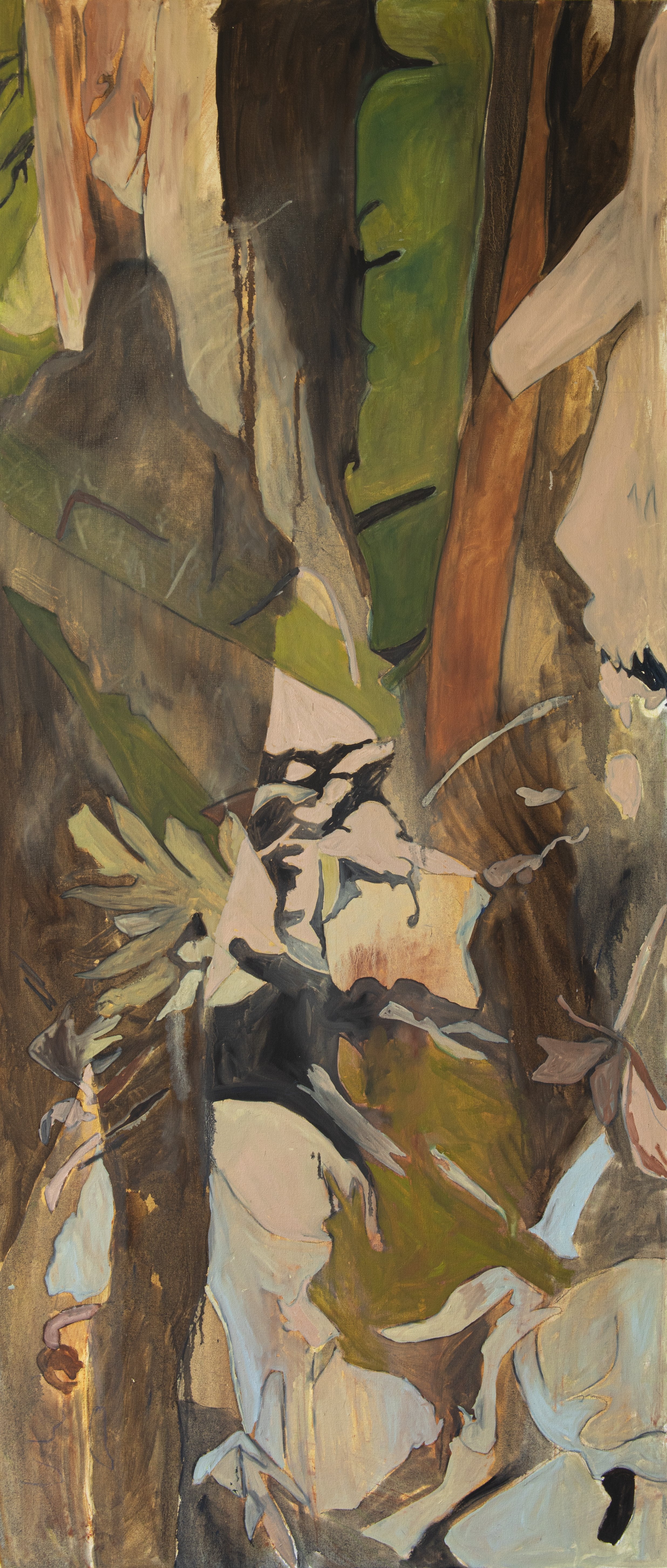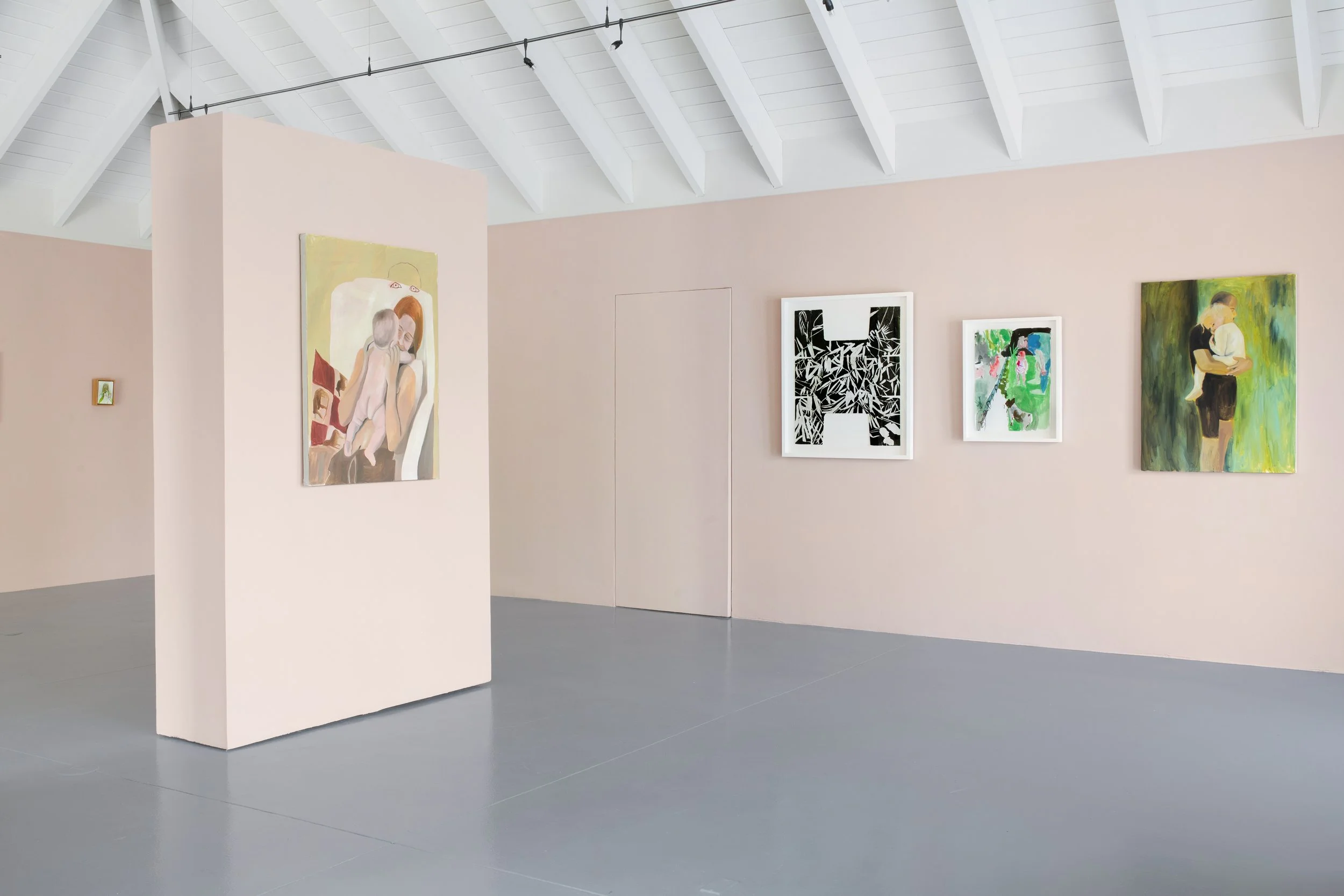Exhibition Essay
It is the light we carry: Tessa Whitehead’s explorations of love, family and light in the Bahamian landscape.
written by Janice Cheddie, PhD
Bahamian multi-media artist Tessa Whitehead’s paintings and drawings are intimate glimpses into the Caribbean every day, the local, and the domestic. A lacuna of abundance and opacity. Within her images, the artist conceives of the Bahamian archipelago as spaces inhabited by feminine spectral presences. Her artistic vision positions this terrain as a metaphor for interpersonal relationships—where connections to the land are perceived and experienced through the senses. Whitehead’s use of light and shade deftly explores her well-honed grasp of what is perhaps the most difficult aspect of Caribbean visual representation: namely capturing the quality and range of Caribbean natural light. Within popular culture, the natural light of the Caribbean is too often seen only through the prism of its noon-time peak on white sandy beaches or dappled through the shades of palm trees. What is often missed in these representations, is the interior. In Whitehead’s paintings the viewer sees Caribbean light as it is experienced within daily life: in the gap, through the vegetation of an unmarked space that gives way to a neighbor’s house or an hidden path to the local store or ravine. It becomes a light deeply felt on and within the skins and bodies of its diverse inhabitants.
Installation view of “Carry”, a solo exhibition by Tessa Whitehead
Whitehead’s painterly gaze challenges the assertion that the function of representation is to be a facsimile of the real. Drawing the viewer into the space, between the digital photograph as a document and the medium of paint. In that space Whitehead focuses her attention on mark making, brush work, gesture and color palette. Whitehead’s paintings give the viewer a vibrant exploration of the spectrum of light within the landscape.
Using color temperature, light, and hue to conjure up the physical and sensorial ties to the ground beneath our feet. While the digital snapshot seeks to reduce the transient to a captured moment in time. Whitehead observes refractions, shade, fleeting shadows and people located within the landscape. The point of view of one familiar with the Bahamian landscape, and the complex bonds between the land and its inhabitants.
Shadow of something, 2024, Tessa Whitehead, Oil on canvas, 70 x 30 in. (177.8 x 76.2 cm.)
In Shadow of Something, 2024, Whitehead’s color palette moves between subtle hues of oranges and browns. Adroitly illustrating the dark vegetation absorbing the intense heat of the sun. Although daytime, the sun’s position is unclear, making it difficult for the viewer to see where the light has fallen to cast the only shadow in the painting. The long narrow canvas deliberately presents the viewer with a restrictive view of two figures, within a woodland glade. One figure is a genderless full-length shadow, and the other figure, is a more solid naked figure, with only its upper torso on view. Its left hand is missing from the right edge of the frame. Its gaze directed toward the shadow. Is the shadow looking toward or away from the fragmented figure? The compact vegetation between the two figures with no clear paths to cross, indicates a distance between the figures.
The lack of two fully embodied presences within the painting invites the viewer into space of questioning. Is the shadow, or possibly both figures, phantasmal presences? The calm, stillness of the solid figure hints at a familiarity between the two presences. Has the painter reproduced the beginning or an end of an encounter between the two? Or are these figures simply moving through the thicket? Is this a moment of familiarity? Or perhaps a chance encounter? The painter does not yield any answers, rather Whitehead invites the viewer to enter her imaginary space. Where vegetation, at times, takes on anthropomorphic qualities. The palm at the bottom of the frame resembles a hand reaching out, blending into the shadow. By not presenting a dominant figure within the painting, Whitehead suggests a transitory moment of equivalence between the two presences.
Installation view of Carry, a solo exhibition by Tessa Whitehead
The critic Jill Casid in Sowing Empire: Landscape and Colonisation (2014) analyzes how the vegetation and natural landscape of the colonial Caribbean were transformed. Through cross-continental transplantation of flora and fauna to create an idealized Imperial vision of a tropical landscape. Its function was to mask the ecological depletion caused by the monoculture plantation agricultural farming system. These transplants occurred alongside the forced and voluntary mitigations of people. The Lucayan Archipelago we see today, has itself been curated, idealized and reimagined. What is native to the soil and topography of the Bahamas and the wider Caribbean? What has been imported? What is the product of hybridity? These migrated species have merged and climatised into the native soil. Bringing into the present other histories – natural, transplanted and manufactured. Holding within their diverse rhizomatic structures, Derridean hauntologies of lost possible futures. The flora and fauna forming new nodes of adaptation and survival. Fragments of submerged and entangled histories. Is the silhouette in Shadow of Something, 2024, part of these converging and competing lost possibilities? Or simply a play of light? Perhaps, a departing presence? Are the figures within the image musing on their individual and collective relationships to the land? Or is this an encounter of negotiation and entanglement? Here, Whitehead opens to the viewer the prospect of the shadow, being a liminal figure, moving between day and night, dreaming and waking, past and future.
Installation view of Morning walk with Carrier, 2022, Tessa Whitehead
Nature is imagined in many cultures as a mother, female and fertile. However, the landscape is also a marker of geological time, separate from the rhythms of biological or mechanical time. Linking nature and human reproduction, as that which carries both past, present and future in close proximity. Temporality as a lived experience, present in natural cycles, seasons, reproduction and aging. In Carry Whitehead’s paintings such as Morning walk with carrier, 2022, Weight, 2022 and Carrier, 2024, reference the causal family snapshot. Transposed onto the canvases of large-scale figurative painting. In Presenting Baby to Landscape III, 2024, Whitehead captures a woman lifting a small child up to elicit a moment of connection and joy between the caregiver and infant. The child is raised up looking down at the woman, seen only with her back to the viewer. Her white shorts and blue t-shirt stand in stark contrast to the greens of the landscape and the child. By lifting the child into the air, the woman gives the child a changed perspective. An ability to view the world, from a position of height: an adult’s perspective. The baby is lifted up, not into a blue or light sky, although it is seemingly daylight. Whitehead represents the sky through shades of green moving from warmer darker shades to cooling light. Demonstrating her expert use of color spectrum and its importance in conveying the complexity and richness of Caribbean light. The darker shades in this image do not convey a foreboding presence - but the shady coolness of a tropical grove. Whitehead’s coloring of the infant’s skin, features, and clothing, mirror the green hues of the sky and surrounding slender, tall plants and trees that encompass the child. Here Whitehead hints at an affinity between the infant and the natural environment. Her use of color for the child and the adult also render them racially indeterminate, echoing the Bahamian hybridized ecologies.Not so such a presentation of the child to the landscape, more a blending and mingling between the two. The grove and its sky presents an almost feminine motherly embrace, as the child looks at the woman. Bringing forth layers of recognition and connection.
The similarity between the landscape and the infant stands in contrast to visualization of the adult. Whilst the edges of the child’s body are softly rendered within the color palette of landscape. The adult in her white shorts, blue t-shirt and tanned body, are sharply drawn and imply an apartness from nature. In stark contrast to the infant’s closeness to the landscape. At the feet of the woman are four small smooth billed ani,ungainly black birds native to The Bahamas. The bird nearest to the woman stands close to her lower limbs. The woman’s gaze remains fixed on the child. The birds in this moment are not silent on-lookers, but as autonomous presences being nourished by nature. Undisturbed by the human presence. If motherhood, as Whitehead states, is a moment of change - physical, psychological and spiritual. In Carry, Whitehead also positions motherhood as a period of transition, that brings into being the passing on of blended histories, traditions and bloodlines. She presents the carrying and nurturing of new life, not as a burden, but as a continuum of connection and exchange. The child, within Presenting Baby to Landscape III, 2024, emerges as a totemic symbol of possible futures, carrying with it the differing temporalities of nature and culture, tradition and change. Bringing forth an intimate connection between nature and humanity.
Tessa Whitehead (b. 1985) is a multi-media artist working primarily in painting. She received her BA in Fine Arts from Central Saint Martins College of Art and Design (2007) and her MFA from The Slade School of Fine Art, UCL, London (2009). Whitehead's most recent solo exhibition was at The National Art Gallery of The Bahamas in 2019. She has participated in group exhibitions including Beginning, The Brighton Storeroom, Barbados (2019); Ubersee, Halle 14, Spinnerei in Leipzig, Germany (2017); Showoff, Cooke Latham Gallery (2020); Nassau Calling (collaborative with Heino Schmid), at HilgerBROTKunsthalle, Vienna, Austria (2015); and Showoff (with Heino Schmid), curated by LeandaKateLouise, London, UK (2015).
Janice Cheddie PhD is a London-based writer, researcher and consultant. Janice was born in St Lucia, and migrated to London as part of the Children of Windrush migration. She has published widely on issues of visual culture, cultural difference, cultural democracy and cultural participation.





